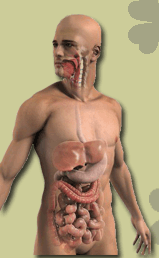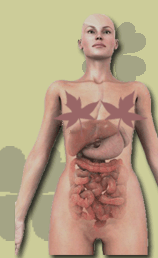|
Parasitic worms in the human intestinal tract can cause fatigue, discomfort and disease. These 6 worms can invade the human body and cause severe problems:
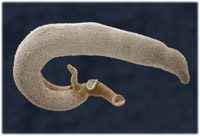 The blood fluke or Schistosoma is a type of flatworm. It causes the tropical disease, Schistosomiasis. The disease is also called Bilharziasis, Snail Fever and Swimmer’s Itch and is caused by contact with fresh water infested with the cercariae parasite. The cercariae is a form of schistosoma or blood fluke. The cercariae can live outside a host for up to 48 hours and enters the human body through the mouth, skin or the gastrointestinal tract. The blood fluke or Schistosoma is a type of flatworm. It causes the tropical disease, Schistosomiasis. The disease is also called Bilharziasis, Snail Fever and Swimmer’s Itch and is caused by contact with fresh water infested with the cercariae parasite. The cercariae is a form of schistosoma or blood fluke. The cercariae can live outside a host for up to 48 hours and enters the human body through the mouth, skin or the gastrointestinal tract.
Male and female worms produce eggs in the intestines or bladder of their human host. A female worm may lay up to 2,000 eggs every day for twenty years. The eggs that don’t leave the human body through the intestines may become embedded in the tissues and this can cause Schistomiasis.
Schistomiasis symptoms often start with a general feeling of sickness followed by a minor rash or tingling feeling on the skin. Many people infected with Schistomiasis have no symptoms. Those that do may experience fever, aches, enlargement of glands, coughing and diarrhea a few weeks or a few months after infection.
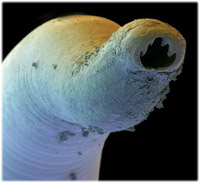 The hookworm is a type of roundworm. Hookworms move their bodies from side to side until they attach to their host. When they enter the intestine they use their teeth to hook into the intestinal wall. They ingest portions of the colon wall which can result in dead tissue. Since blood is lost as the hookworms feed on their human host’s intestinal tract, serious iron deficiency can result in severe hookworm infestations. The hookworm is a type of roundworm. Hookworms move their bodies from side to side until they attach to their host. When they enter the intestine they use their teeth to hook into the intestinal wall. They ingest portions of the colon wall which can result in dead tissue. Since blood is lost as the hookworms feed on their human host’s intestinal tract, serious iron deficiency can result in severe hookworm infestations.
A hookworm can produce over 30,000 eggs per day. Hookworm infections, called Ancylostomiasis, are mainly contracted by walking barefoot in dirt. The hookworm enters the bloodstream, lungs and windpipe to get to the intestinal tract.
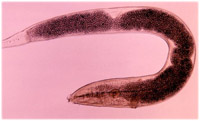 The pinworm is a type of roundworm that is extremely infectious. The main symptom of a pinworm infestation is itchiness in the anal area. If a person with pinworms scratches that area it is easy to infect others as the eggs can collect under the fingernails. Just about any surface can be contaminated with pinworms such as clothing, towels, sheets and carpeting. Pinworms may be especially troubling to women as some worms may end up in the uterus, fallopian tubes or vulva. The pinworm is a type of roundworm that is extremely infectious. The main symptom of a pinworm infestation is itchiness in the anal area. If a person with pinworms scratches that area it is easy to infect others as the eggs can collect under the fingernails. Just about any surface can be contaminated with pinworms such as clothing, towels, sheets and carpeting. Pinworms may be especially troubling to women as some worms may end up in the uterus, fallopian tubes or vulva.
Pinworms are threadlike white worms that are sometimes called threadworms. They are likely to be able to be seen with a flashlight because exposure to light can cause them to glow. A piece of tape applied to the skin around the anus (perianal skin) and then removed can be checked for worms and/or eggs.
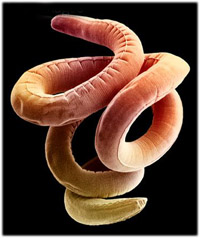 Roundworms have three puncturing formations on their mouths and three lips. They can enter the human body through hand to mouth transmission or through the skin. There are at least 15, 000 species of roundworms and some of these can produce 200,000 eggs per day. Roundworms have three puncturing formations on their mouths and three lips. They can enter the human body through hand to mouth transmission or through the skin. There are at least 15, 000 species of roundworms and some of these can produce 200,000 eggs per day.
One handful of dirt may contain thousands of roundworms. There are often no symptoms of roundworms in the human body, except when roundworm larvae take up space in the eyes or nerves. Nerve damage and blindness may result. Some species of roundworms can cause stiff muscles and headaches. Other symptoms of intestinal roundworms include abdominal cramping, gas, bloating, diarrhea, constipation, coughing, fever and clear strands of mucus in the stool.
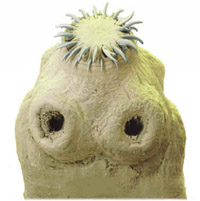 The tapeworm is a type of flatworm. Human tapeworms belong to the parasite family, Cestoda. Obvious symptoms are rare in human tapeworm infestations. This is unfortunate since if the human tapeworm enters muscle tissue and organs it can cause parasitic disease. For example, in Alveolar Hydatid Disease (AHD), the tapeworm species, Echinococcus, enters the circulatory system from the intestinal wall and causes parasitic tumors throughout the body. The tapeworm is a type of flatworm. Human tapeworms belong to the parasite family, Cestoda. Obvious symptoms are rare in human tapeworm infestations. This is unfortunate since if the human tapeworm enters muscle tissue and organs it can cause parasitic disease. For example, in Alveolar Hydatid Disease (AHD), the tapeworm species, Echinococcus, enters the circulatory system from the intestinal wall and causes parasitic tumors throughout the body.
Depending on the species, tapeworms may consume body tissue with either hooks or suckers. Human tapeworms can live in the body up to 30 years and grow up to 30 feet long.
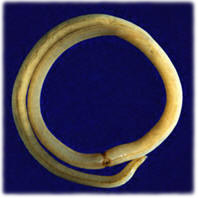 The Whipworm is a type of round worm. Whipworms are whip-shaped with a wider portion at one end that tapers into a long narrow whip. When whipworms enter the large intestine or colon in humans they can cause trichuriasis. Whipworms release a digestive liquid on the colon wall that makes the tissue easier for them to digest. Trichuriasis is a worldwide problem. The Whipworm is a type of round worm. Whipworms are whip-shaped with a wider portion at one end that tapers into a long narrow whip. When whipworms enter the large intestine or colon in humans they can cause trichuriasis. Whipworms release a digestive liquid on the colon wall that makes the tissue easier for them to digest. Trichuriasis is a worldwide problem.
Whipworm eggs may be ingested in grains such as rice and beans. Unless the infestation is heavy, symptoms such as bloody diarrhea may not occur. Blood loss over a long period of time can lead to iron-deficiency anemia. Whipworms live in the large intestine or colon. Females may produce more than 10,000 eggs daily.
|

